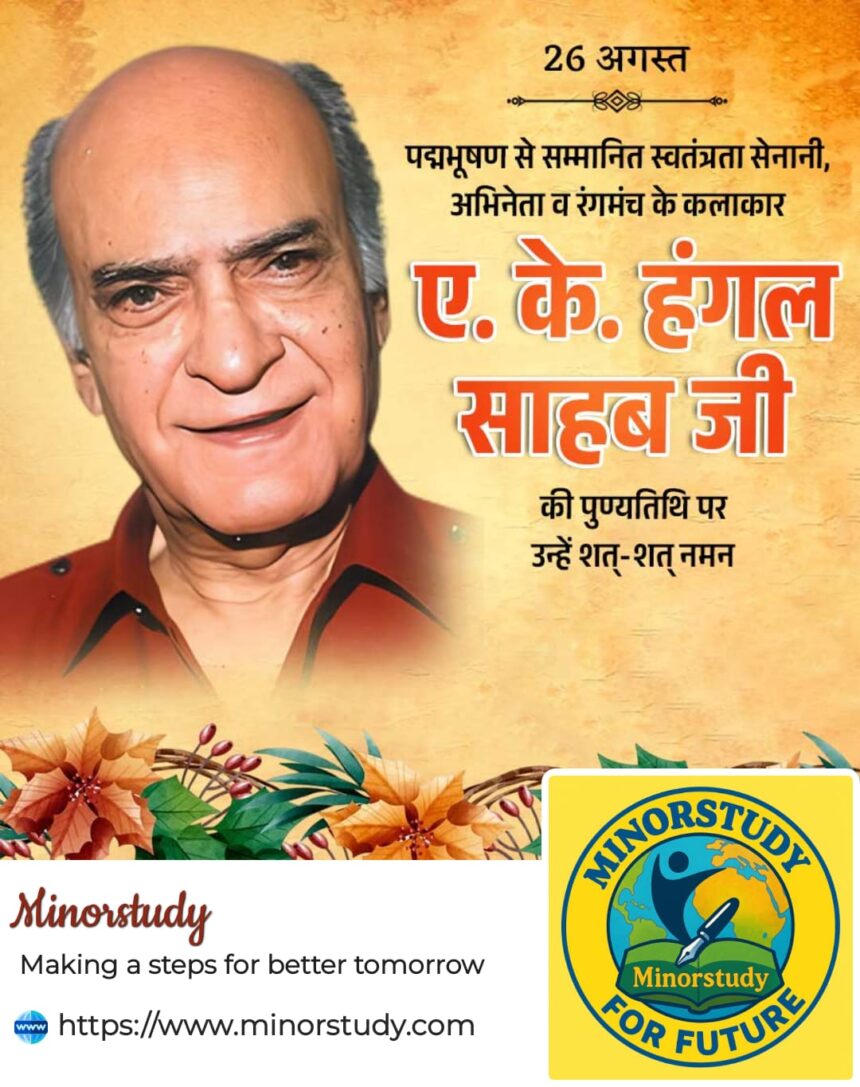Introduction
When we talk about the golden era of Indian cinema, names of legendary actors like Dilip Kumar, Raj Kapoor, and Amitabh Bachchan come to mind. Yet, behind every hero and heroine, there were character actors who brought depth, emotion, and authenticity to films. One such unforgettable name is A.K. Hangal Sahab Ji – a man who lived a life larger than cinema itself.
- Introduction
- History of A.K. Hangal Sahab Ji
- Timeline of A.K. Hangal’s Life
- Inspiring Facts About A.K. Hangal Sahab Ji
- Significance of A.K. Hangal Ji in Indian Cinema
- Observance and Tributes
- Importance of A.K. Hangal Ji in Our Life and Society
- Wishing and Remembering A.K. Hangal Ji
- FAQs About A.K. Hangal Sahab Ji
- Conclusion – Daily Life Impacts of A.K. Hangal Ji
Known lovingly as the “on-screen father and grandfather” of Bollywood, A.K. Hangal was not just an actor but also a freedom fighter, a socialist, and a true humanist. His simplicity, honesty, and emotional portrayals left audiences teary-eyed for decades.
In this article, we’ll explore the complete history, timeline, facts, FAQs, significance, observance, and daily life impacts of A.K. Hangal Ji, while keeping a warm, human-friendly tone.
History of A.K. Hangal Sahab Ji
Full Name: Avtar Kishan Hangal
Birth: 1 February 1914, Sialkot (now in Pakistan)
Death: 26 August 2012, Mumbai, India
Occupation: Actor, Freedom Fighter, Theatre Artist
Active Years: 1966 – 2005 (Cinema & Theatre)
Born in Sialkot, Punjab (before Partition), A.K. Hangal lived through one of the most turbulent phases of Indian history. Before stepping into Bollywood, he was a freedom fighter against British colonial rule and was imprisoned for his activism. Later, he became a prominent member of the Indian People’s Theatre Association (IPTA) – an organization that combined art and activism.
He entered Bollywood relatively late in life, at the age of 50+, yet he went on to act in more than 225 films. His roles in Sholay (1975), Bawarchi (1972), Namak Haraam (1973), and Shaukeen (1982) made him a household name.
Timeline of A.K. Hangal’s Life
1914: Born in Sialkot, Punjab (British India).
1930s – 1940s: Joined freedom movement against British rule.
1947: Partition of India – migrated to Bombay.
1949–1965: Active in theatre (IPTA) – performed in progressive plays.
1966: First Bollywood break in Teesri Kasam.
1970s – 1980s: Golden period – iconic roles in Sholay, Namak Haraam, Shaukeen, Bawarchi.
1990s: Continued working in films and TV serials despite old age.
2006: Awarded Padma Bhushan for his contribution to arts.
2012: Passed away in Mumbai at the age of 98.
Inspiring Facts About A.K. Hangal Sahab Ji
He was a freedom fighter before becoming an actor.
He joined films at an age when most actors retire – around 50.
Acted in more than 225 films across 4 decades.
He is remembered for his humble, poor, or fatherly roles.
His famous dialogue in Sholay – “Itna sannata kyun hai bhai?” – remains iconic.
He worked with all leading stars of his era, from Rajesh Khanna to Amitabh Bachchan.
Despite his fame, he lived a very simple and modest life.
In his old age, he faced severe financial difficulties but refused to beg or compromise on self-respect.
He was a member of Communist Party and IPTA, always fighting for social justice.
He received Padma Bhushan in 2006, one of India’s highest civilian awards.
Hangal Ji worked in television serials too, including Madhubala and Shararat.
His son Vijay Hangal stood by him during his last years.
He lived to be 98 years old, spanning almost a century of Indian history.
He believed cinema is not just entertainment, but a mirror to society.
Even when bedridden, he said: “Mujhe abhi bhi acting karni hai” (I still want to act).
Significance of A.K. Hangal Ji in Indian Cinema
A.K. Hangal symbolized realism and humanity in cinema. While many actors focused on glamour, Hangal Ji chose to play ordinary men – the poor farmer, the helpless father, the struggling clerk, or the honest teacher.
He gave a voice to the common man in Bollywood.
His portrayals made people cry and connect deeply with cinema.
He was proof that acting is not about age, but about truth and talent.
He kept progressive ideology alive in Bollywood through IPTA plays.
Observance and Tributes
Every year on his birth anniversary (1 February) and death anniversary (26 August), cinema lovers, IPTA members, and film historians pay tribute to his contributions. TV channels often air Sholay or Bawarchi during these times.
His legacy is also carried forward by theatre groups who draw inspiration from his art-as-activism philosophy.
Importance of A.K. Hangal Ji in Our Life and Society
Inspiration for Late Beginners: Hangal Ji’s success story teaches us that age is never a barrier to starting something new.
Human Values: His characters reminded audiences of compassion, simplicity, and truthfulness.
Cultural Bridge: He lived through pre-independence, partition, and modern India, connecting generations through his life story.
Role Model: His personal struggles highlight the importance of dignity over wealth.
Wishing and Remembering A.K. Hangal Ji
✨ “On the birth and remembrance day of A.K. Hangal Sahab Ji, we salute the man who gave dignity to ordinary characters and proved that true acting lies in simplicity. May his soul continue to inspire generations.” ✨
If you want to wish in simple words:
👉 “Happy Remembrance to A.K. Hangal Ji – the heart of Bollywood’s golden age.”
FAQs About A.K. Hangal Sahab Ji
Q1: Who was A.K. Hangal?
A.K. Hangal was an Indian actor, freedom fighter, and theatre activist best known for playing fatherly roles in Hindi cinema.
Q2: What was A.K. Hangal famous for?
He was famous for his emotional and humble character roles, especially in Sholay, Namak Haraam, and Bawarchi.
Q3: Did A.K. Hangal face poverty in old age?
Yes, despite acting in over 200 films, he struggled financially in his later years but remained dignified.
Q4: Which awards did he receive?
He received the Padma Bhushan (2006) for his contribution to arts and cinema.
Q5: How did A.K. Hangal inspire people?
He proved that acting is about truth and emotions, not glamour. His life showed resilience, simplicity, and courage.
Conclusion – Daily Life Impacts of A.K. Hangal Ji
A.K. Hangal Sahab Ji’s life is not just the story of an actor but of a fighter, thinker, and compassionate human being.
In daily life, his story teaches us to never give up, even if success comes late.
He inspires us to stay grounded, humble, and true to values.
His struggle in old age reminds society to care for its senior citizens and real artists.
His legacy continues every time we watch Sholay or Bawarchi and feel emotional at his simple yet powerful screen presence.
In the end, A.K. Hangal Ji remains a symbol of perseverance, humility, and the true spirit of art.








